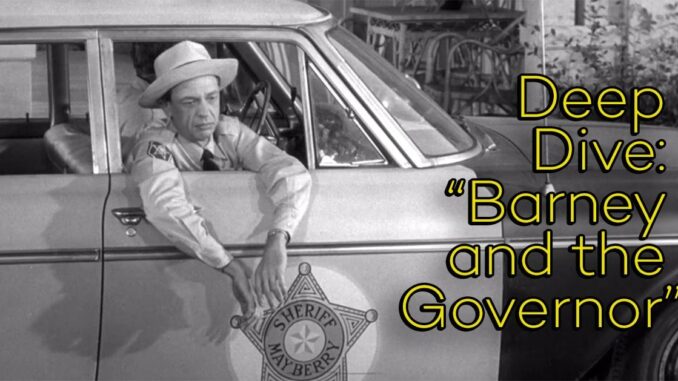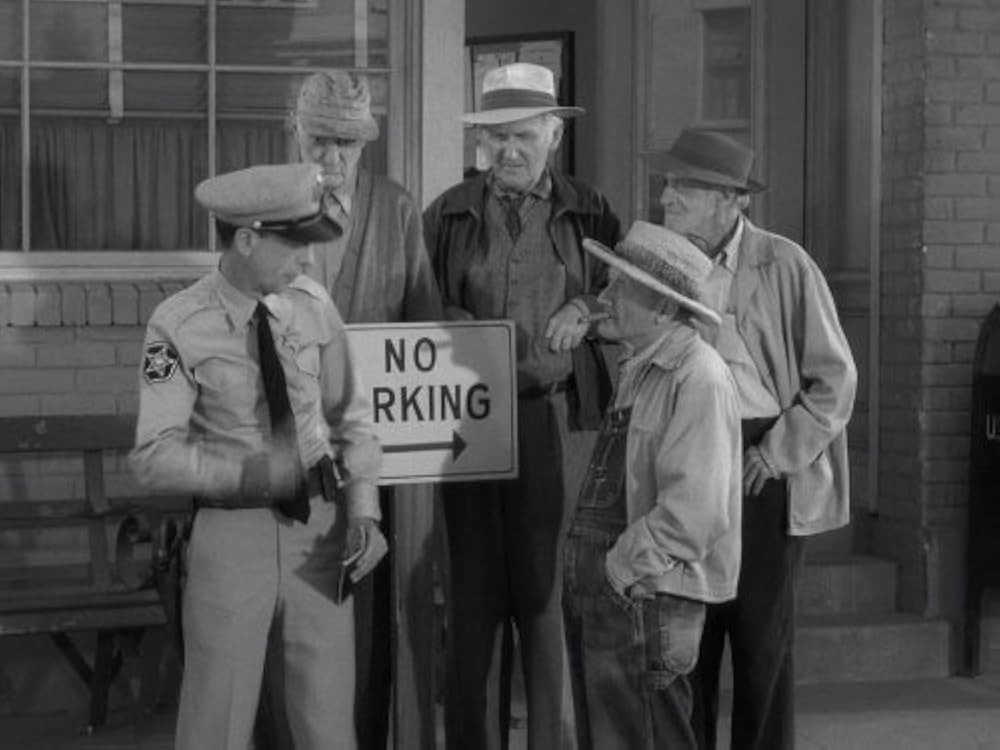
1. Barney’s Tie Pin That Tells a Story
Blink and you’ll miss it — but Barney’s tie pin in this episode isn’t just a piece of costume jewelry. It’s an old-style horseshoe-shaped clip he wears like a badge of honor. Why does that matter?
Because it reflects his constant need to assert authority. This little accessory quietly reinforces Barney’s psychological need to feel official — even when he’s out of his league with the Governor.
2. The Governor’s Car – A Symbol of Power and Simplicity
When the Governor arrives in Mayberry, his car is a sleek, black sedan — nothing flashy, but undeniably authoritative. It’s not just a vehicle; it’s a subtle storytelling device. It contrasts heavily with the worn-down sheriff’s squad car, hinting at the power imbalance and formality clashing with Mayberry’s laid-back nature.
3. Andy’s Subtle Manipulation in the Background
You’ll notice Andy’s trademark tactic in full force: stay calm, say little, and let people dig their own holes. In several scenes, he quietly encourages Barney to keep talking, knowing full well it’s going to end in chaos. Andy’s expressions and eye movements do more storytelling than the script.
4. The Sheriff’s Office Chalkboard – More Than Just a Prop
Look closely at the blackboard behind Andy’s desk. It’s filled with scribbles and notes from previous episodes — some even nonsensical. But that’s the point: it gives the sense of a working office, grounding the show in realism. Even though the scenes are clearly staged, those chalkboard markings help keep the illusion alive.
5. A Curious Mention of “Miss Crump” Before She Arrives in Mayberry
Here’s a juicy one for continuity fans: Andy casually mentions a schoolteacher before Helen Crump officially joins the show. While not named directly, it’s clear the writers were testing waters or laying early groundwork. It’s a peek into the evolving storyline — and how the show built its world slowly, one tiny line at a time.
6. The Larger Message Behind a Seemingly Simple Plot
“Barney and the Governor” isn’t just about a ticket and some awkward politics. It’s about integrity, standing your ground, and the power of small-town decency. The episode flips expectations — the Governor is humbled, while Barney (accidentally) takes a stand. There’s a deep message under all the laughs.

7. Don Knotts’ Facial Acting – Silent but Loud
Forget the dialogue. Watch Don Knotts’ face. His eyes darting, mouth twitching, body squirming — it’s all an intricate dance of anxiety. In scenes where he doesn’t speak a word, he still steals the show. It’s pure physical comedy gold, echoing silent film legends like Buster Keaton.
8. The Evolving Set of Mayberry’s Courthouse
If you’ve watched enough episodes, you’ll notice the courthouse shifts subtly over time. In this episode, the position of furniture and props gives the room a more “official” feel — perhaps a deliberate choice to reflect the presence of the Governor. That’s intentional set design at its finest.
9. How Sound Design Shapes the Governor’s Visit
Pay attention to how quiet things get when the Governor arrives. The usual background noise — footsteps, doors, radio static — fades out. It creates an invisible tension. Even the laugh track dips during his entrance. It’s subtle, but it shifts the mood instantly.
10. The Episode’s Title Card – A Subtle Joke Itself
The title “Barney and the Governor” is structured like a buddy comedy — but in reality, it’s a clash of worlds. The title itself is a misdirect, teasing a friendship that never really forms. It’s classic sitcom irony — and clever writing.
11. Body Language Between Andy and Barney
Watch how Andy always positions himself slightly behind Barney in scenes with authority figures. It gives Barney the illusion of control, even when Andy’s really pulling the strings. It’s classic leadership — support from the shadows.
12. A Wink to Viewers with the “No Parking” Sign
One throwaway gag involves a “No Parking” sign being moved by Barney to issue tickets. But if you look closely, that same sign appears in at least three previous episodes in different places — sometimes even indoors! It’s a recurring prop gag for fans paying close attention.
13. Cultural Context You Might’ve Missed
This episode aired in 1963 — a time when public trust in government was still high, but cracks were forming. The Governor’s gentle humility reflects the ideal politician of the time: accessible, relatable, not too far removed from the common man. It’s a subtle nod to post-WWII optimism clashing with rising skepticism.
14. Why the Governor Scene Feels So Awkwardly Real
The infamous scene where Barney panics in front of the Governor is funny — but also painfully relatable. That’s because it wasn’t entirely scripted. Don Knotts improvised parts of his dialogue, and the crew kept the first take. That real anxiety? 100% genuine.
15. The Importance of Pacing in This Episode
Unlike more frantic episodes, “Barney and the Governor” uses slow pacing to its advantage. Long pauses. Awkward silences. Scenes allowed to breathe. It’s a reminder that comedy isn’t just about punchlines — it’s about timing. The tension builds… then explodes in laughter.
Conclusion: Small Details, Big Impact
What makes The Andy Griffith Show so enduring? It’s not just the jokes or the nostalgia — it’s the attention to detail. “Barney and the Governor” might look like a simple sitcom episode on the surface, but dig a little deeper and it’s clear: every line, prop, and glance has a purpose. These five (and more) subtle details remind us why Mayberry still feels so real — and why fans keep coming back, decade after decade.
